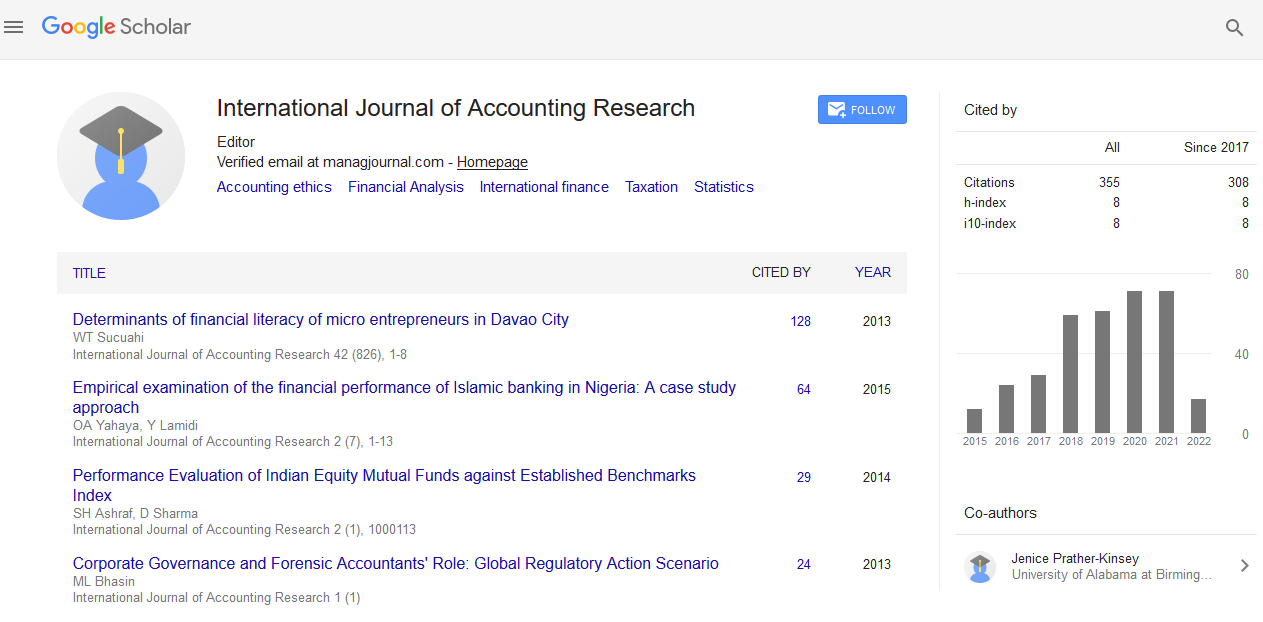Indexed In
- Open J Gate
- RefSeek
- Hamdard University
- EBSCO A-Z
- Scholarsteer
- Publons
- Euro Pub
- Google Scholar
Useful Links
Share This Page
Journal Flyer

Open Access Journals
- Agri and Aquaculture
- Biochemistry
- Bioinformatics & Systems Biology
- Business & Management
- Chemistry
- Clinical Sciences
- Engineering
- Food & Nutrition
- General Science
- Genetics & Molecular Biology
- Immunology & Microbiology
- Medical Sciences
- Neuroscience & Psychology
- Nursing & Health Care
- Pharmaceutical Sciences
Opinion Article - (2025) Volume 13, Issue 1
Green Accounting Practices in Corporate Reporting: A Rising Need in Sustainability Era
Shreya Deshmukh*Received: 03-Mar-2025, Manuscript No. IJAR-25-29098; Editor assigned: 05-Mar-2025, Pre QC No. IJAR-25-29098 (PQ); Reviewed: 19-Mar-2025, QC No. IJAR-25-29098; Revised: 26-Mar-2025, Manuscript No. IJAR-25-29098 (R); Published: 02-Apr-2025, DOI: 10.35248/2472-114X.25.13.412
Description
As the global economy pivots toward sustainability and environmentally responsible practices, the relevance of green accounting in corporate reporting has grown significantly. Green accounting, also known as environmental accounting, integrates environmental costs into financial decision-making and reporting processes. This practice seeks to capture the financial impact of a company’s environmental responsibilities such as resource consumption, pollution, carbon footprint, and ecological restoration within the traditional accounting framework. The growing interest in green accounting reflects a broader shift in the business world, where sustainability is no longer a fringe concern but a central factor in operational and strategic planning.
One of the key drivers of green accounting is the increasing pressure from stakeholders, including investors, consumers, regulators, and civil society, to disclose environmental impacts and sustainability efforts transparently. Companies are now expected not only to report their profits but also to demonstrate their commitment to environmental stewardship. This shift in expectations has led to the incorporation of environmental performance indicators in financial reports and the emergence of Environmental, Social, and Governance (ESG) frameworks as a standard for ethical investing.
Green accounting provides companies with a structured way to evaluate the environmental costs of their operations. It involves tracking resource usage, waste production, energy consumption, and emissions. These environmental variables are then translated into monetary terms, enabling organizations to understand the true cost of their activities. For instance, a manufacturing firm may calculate the cost of water pollution resulting from its processes and include this figure in its internal cost accounting. This approach allows businesses to identify inefficiencies, assess environmental risks, and make informed investment decisions.
Moreover, green accounting supports long-term financial performance by highlighting areas where sustainable practices can reduce costs and liabilities. Energy-efficient equipment, waste reduction initiatives, and renewable energy usage may involve initial investments but often result in substantial savings over time. By capturing these impacts, green accounting helps organizations build resilience and future-proof their operations against rising environmental compliance costs and reputational risks.
On the policy front, several governments and international institutions have begun advocating for or mandating environmental reporting. The European Union’s Corporate Sustainability Reporting Directive (CSRD), for example, requires large companies to disclose a broad range of sustainability information. Similar trends are observable in countries such as Canada, Australia, and India, where sustainability disclosures are becoming integral to corporate reporting requirements. These regulations are encouraging businesses to adopt green accounting practices to remain compliant and competitive.
From an accounting perspective, integrating environmental data into financial statements poses several challenges. Traditional accounting systems are primarily designed to capture monetary transactions, not ecological variables. Therefore, companies must invest in new tools and methodologies that enable the quantification of environmental impacts. This often involves collaboration with environmental scientists, data analysts, and sustainability experts to collect, verify, and interpret complex environmental data.
Another hurdle lies in the lack of standardized frameworks for environmental accounting. While organizations such as the Global Reporting Initiative (GRI) and the Sustainability Accounting Standards Board (SASB) provide guidelines, there is still significant variation in how companies measure and report environmental performance. This lack of uniformity makes it difficult for stakeholders to compare performance across firms or industries. Efforts are underway to harmonize these standards, with initiatives such as the International Sustainability Standards Board (ISSB) aiming to create a global baseline for sustainability reporting.
The integration of green accounting into mainstream corporate practices also requires a cultural shift within organizations. Executives and financial managers must recognize that environmental impacts are not externalities to be ignored but strategic factors that influence long-term profitability and risk. Accounting professionals need training in sustainability metrics and must develop a broader understanding of ecological economics to effectively fulfill their roles in this evolving landscape.
Additionally, the use of green accounting supports ethical and transparent decision-making. By disclosing the true costs of environmental degradation, companies can foster greater accountability and trust with stakeholders. This transparency not only enhances brand reputation but also attracts investors who prioritize sustainability. A growing body of evidence suggests that companies with strong environmental performance tend to enjoy better market valuations, lower capital costs, and greater operational efficiency.
Citation: Deshmukh S (2025). Green Accounting Practices in Corporate Reporting: A Rising Need in Sustainability Era. Int J Account Res.13:412.
Copyright: © 2025 Deshmukh S. This is an open access article distributed under the terms of the Creative Commons Attribution License, which permits unrestricted use, distribution, and reproduction in any medium, provided the original author and source are credited.


